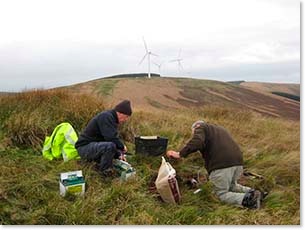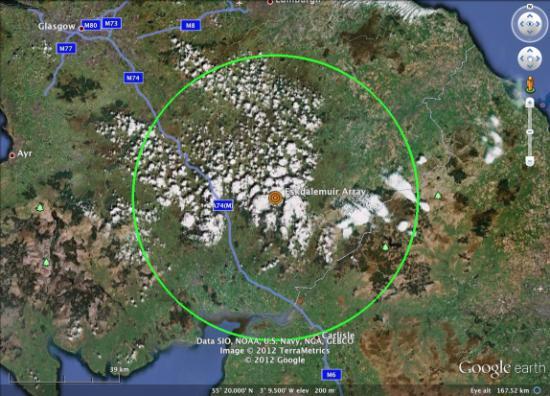Wind turbine vibrations
Our group has many years experience of in monitoring the low-frequency vibrations from wind turbines. These low-frequency vibrations can be problematic for installations that are sensitive to seismic noise, such as seismic monitoring stations and other sensitive scientific instruments.
Previous Work
In excess of 1 Gigawatt of wind generation capacity was planned for the southern uplands of Scotland. However, the United Kingdom seismic monitoring site which constitutes our component of the Comprehensive Test Ban Treaty for monitoring compliance for nuclear testing is situated at Eskdalemuir near Langholm in the Scottish Borders. The Ministry of Defence, therefore, placed a precautionary blanket objection to any wind farm developments within 80 km of Eskdalemuir in case this compromised our capacity to detect distant nuclear test and breached our agreement under the CTBT. This effectively removed at least 40% of the UK renewable wind resource identified by the DTI.
 Because of our previous, unique experience in monitoring seismic vibrations from wind turbines in the UK, the Applied and Environmental Geophysics Group of the School of Physical and Geographical Sciences, were asked by the MOD, the DTI and the British Wind Energy Association to investigate whether there was a solution to this impasse. By carrying out a detailed programme of seismic and infrasound measurements in the vicinity of several wind farms in Scotland we were able to identify the characteristic frequencies and mode of propagation of seismic vibrations from wind turbines and develop a model for the integrated seismic vibration at the Eskdalemuir site which will be created by any distribution of wind farms. By setting a noise budget that is permissible at Eskdalemuir without compromising its detection capabilities, we have demonstrated that at least 1.6 GW of planned capacity can be installed and have developed software tools that allow the MOD and planners to assess what further capacity can be developed. The MOD have now lifted the 80 km exclusion and any further wind farm proposals will be assessed against criteria established by this study. The statutory consultation zone of 50km is shown in the figure below.
Because of our previous, unique experience in monitoring seismic vibrations from wind turbines in the UK, the Applied and Environmental Geophysics Group of the School of Physical and Geographical Sciences, were asked by the MOD, the DTI and the British Wind Energy Association to investigate whether there was a solution to this impasse. By carrying out a detailed programme of seismic and infrasound measurements in the vicinity of several wind farms in Scotland we were able to identify the characteristic frequencies and mode of propagation of seismic vibrations from wind turbines and develop a model for the integrated seismic vibration at the Eskdalemuir site which will be created by any distribution of wind farms. By setting a noise budget that is permissible at Eskdalemuir without compromising its detection capabilities, we have demonstrated that at least 1.6 GW of planned capacity can be installed and have developed software tools that allow the MOD and planners to assess what further capacity can be developed. The MOD have now lifted the 80 km exclusion and any further wind farm proposals will be assessed against criteria established by this study. The statutory consultation zone of 50km is shown in the figure below.


"Eskdalemuir is an excellent example of how industry and government departments can work together to solve problems that could impede progress towards our energy and environmental goals. This agreement is based on solid research, and reflects the goodwill and constructive approach shown by all the parties. It is a welcome boost to our efforts to build a sustainable future energy supply that doesn't harm the environment."
UK Energy Minister, Malcolm Wicks
"I am delighted that, together with the DTI, BWEA, and other stakeholders, we have found a way which has allowed MOD to lift its concerns with a significant number of proposed wind turbines around Eskdalemuir. The way forward, based on the excellent research carried out by Keele University, protects the capability of the array thus allowing us to continue to comply with our obligations under the Comprehensive Test Ban Treaty. This has, from start to finish, been a splendid example of open and joined-up working to solve a complex issue."
MOD Under Secretary of State, Don Touhig
We are now at the point where "noise budget" has been exhausted and the MOD now have a standing objection to any new wind turbine developments within the consultation zone - this includes small and micro turbines. At Keele, we have started a project to look at the impact of small wind turbines on the seismic array at Eskdalemuir. The project aims to both monitor and model various small wind turbines to determine if they have an impact on the detection capabilities of EKA.
This is the final report that we submitted to the MoD, DTi and BWEA with our recommendations.
Dunlaw final report (11,132 KB)
This file may not be suitable for some users of assistive technology
Request an accessible format

